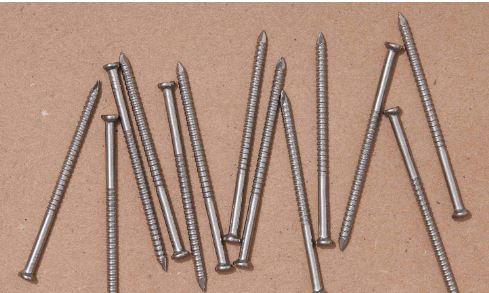Construction nails are indispensable components in the world of building and carpentry. The buildings that make up our homes, workplaces, and infrastructure are held together by these tiny but formidable fasteners. However, have you ever wondered what construction nails are made of? The materials utilized to make these necessary hardware pieces will be examined in depth in this investigation, shedding light on the important elements that give construction nails their strength, durability, and adaptability.
Anyone interested in construction or DIY projects needs to understand the materials that construction nails are constructed of since it can affect the overall quality and durability of the structures we build. So, let’s embark on this journey to uncover the secrets behind the composition of construction nails.
Historical Perspective

The history of construction nails is a testament to human ingenuity and the evolution of construction techniques over the centuries. Since ancient times, nails have been used in many ways for building and woodworking, and as metallurgy and technology have advanced, so too has the makeup of nails.
Ancient civilizations, such as the Egyptians and Romans, used crude nail-like fasteners made from materials like bronze and iron. These early nails were often handmade, each one crafted individually by skilled artisans.
Thanks to advancements in metalworking methods, the production of nails became more systematic during the Middle Ages. Blacksmiths played a pivotal role in forging iron nails, and their designs began to resemble the recognizable form of modern nails. During the Industrial Revolution, the production of nails saw a substantial shift from hand-forged to machine-made.
With the advent of the Industrial Revolution in the 18th century, factories started producing large quantities of standardized nails, making them more affordable and accessible to the masses. These mass-produced nails were typically made of iron or steel.
In the 20th century, technological advancements further revolutionized nail manufacturing. Steel, with its remarkable strength and durability, became the primary material for construction nails. Manufacturers also introduced various coatings to enhance corrosion resistance, further extending the lifespan of these essential fasteners.
As we delve deeper into the historical perspective of construction nails, it becomes evident that these seemingly simple components have a rich and storied past. Their evolution from ancient handmade artifacts to modern, mass-produced steel fasteners reflects the ever-changing landscape of construction and the relentless pursuit of innovation in building materials and techniques. Knowing this history helps us better understand the products and production techniques that have shaped the modern construction sector.
Modern-Day Nail Manufacturing
Modern metallurgy, technology, and quality control techniques have led to previously unheard-of levels of efficiency and accuracy in the production of construction nails. To produce nails that satisfy the high standards of the current construction industry, a combination of conventional methods and cutting-edge technology is used in the manufacturing process.
Material Selection: The choice of materials for modern construction nails is critical to their performance. Due of its great strength and durability, steel is still the preferred material. High-carbon steel or stainless steel is often used, depending on the specific application and environmental factors. Due to their exceptional corrosion resistance, stainless steel nails are perfect for outdoor and maritime applications.
Wire Drawing: The first step in nail manufacturing involves drawing steel wire through a series of dies to reduce its diameter and improve its consistency. This process ensures that the wire meets the desired specifications for nail production.
Cutting and Shaping: The drawn wire is then cut into nail-length pieces, and each piece is shaped into the desired nail form. Automated nail-making machines are used to produce common nails, finish nails, roofing nails, specialized nails and other nails in a variety of lengths and varieties.
Heat Treatment: To enhance the hardness and strength of the nails, they undergo a heat treatment process. This involves heating the nails to a specific temperature and then rapidly cooling them. This heat treatment imparts the necessary toughness to withstand the rigors of construction.
Coating: Many modern nails receive a coating to improve their corrosion resistance. Common coatings include galvanization (a layer of zinc) or various proprietary coatings designed to protect nails from rust and corrosion, especially in outdoor and marine applications.
Quality Control: Stringent quality control measures are employed throughout the manufacturing process. Automated systems and visual inspections ensure that each nail meets the specified standards for size, shape, strength, and coating quality.
Packaging and Distribution: Once nails pass quality control checks, they are packaged in bulk or smaller quantities for distribution to retailers and construction sites worldwide.
Modern nail manufacturing has come a long way from its early handmade origins. Today’s automated production lines can churn out millions of nails with precision and consistency. Modern construction nails are strong and highly corrosion-resistant because to the use of cutting-edge materials, coatings, and quality control procedures, assuring the longevity of structures for many years to come.
Common Materials Used in Construction Nails

A number of materials are used to make construction nails, and each one is chosen for its unique qualities and usefulness for particular uses. Here are some of the most common materials used in the production of construction nails:
Steel: Steel is the most prevalent material for construction nails. It is renowned for its exceptional strength and durability. Steel nails can be further categorized into two main types:
- Carbon Steel: This type of steel is commonly used for general-purpose nails. It provides excellent strength but may be prone to rust if not coated.
- Stainless Steel: Stainless steel nails are highly resistant to corrosion and are ideal for outdoor and marine applications. They maintain their appearance and structural integrity in challenging environments.
Aluminum: Aluminum nails are lightweight and resistant to corrosion, making them suitable for applications where weight and rust are concerns, such as attaching aluminum siding or fastening roofing materials.
Copper: Copper nails are known for their corrosion resistance and aesthetic appeal. They are often used in roofing, gutter installation, and decorative woodworking projects.
Brass: Brass nails combine the corrosion resistance of copper with added strength. They are frequently employed in the construction of boats, woodworking, and as decorative elements.
Galvanized Steel: Galvanized nails are coated with a layer of zinc, providing excellent corrosion resistance. They are a popular choice for outdoor construction and roofing.
Coated Nails: Modern construction nails often feature specialized coatings, such as epoxy or polymer coatings. These coatings enhance corrosion resistance and provide a firm grip when driven into wood or other materials.
Cement-Coated Nails: Nails with cement coatings are designed for use in concrete and masonry. The cement coating improves grip and helps the nail adhere securely to the substrate.
Hot-Dip Galvanized Nails: These nails are submerged in molten zinc, creating a thick, protective coating. They are commonly used in pressure-treated wood and outdoor applications.
Electro-Galvanized Nails: Electro-galvanized nails receive a thinner layer of zinc through an electroplating process. For some indoor and outdoor applications, they provide good corrosion resistance.
The particular needs of the project, such as environmental variables, load-bearing capability, and aesthetic considerations, will determine the type of nail material to use. By selecting the appropriate material, construction professionals can ensure that the nails used in their projects deliver the desired performance and longevity.
FAQs About What Are Construction Nails Made Of
Can I use construction nails in concrete or masonry?
For concrete and masonry applications, it is advisable to use specialized cement-coated nails or concrete nails designed specifically for these materials. These nails have coatings that improve grip and bonding with the substrate.
What is the difference between hot-dip galvanized and electro-galvanized nails?
Hot-dip galvanized nails are coated by immersing them in molten zinc, resulting in a thick, protective layer. Electro-galvanized nails receive a thinner zinc coating through an electroplating process. Hot-dip galvanized nails are generally more corrosion-resistant and suitable for heavy-duty outdoor use.
Are there any environmental considerations when choosing construction nail materials?
Yes, consider the environmental impact of your choice. For example, some coatings may contain environmentally harmful substances. Because they are so strong and resistant to corrosion, stainless steel nails may last longer and need to be replaced less frequently, lowering their overall environmental effect.
How can I ensure the longevity of construction nails in my project?
To maximize the lifespan of construction nails, select the appropriate material for the application, consider the environmental conditions, and follow best practices for installation. Additionally, regular maintenance and inspections can help identify and replace corroded or damaged nails.
Where can I purchase construction nails and get expert advice on the right type for my project?
Construction nails are available at hardware stores, home improvement centers, and online retailers. These stores often have knowledgeable staff who can provide guidance on nail selection based on your specific project requirements.
Final Thought
In the end, the composition of construction nails is a critical aspect of their performance and durability. As we have explored in this discussion, construction nails are primarily made of various materials, including steel, stainless steel, and aluminum. These materials are selected due to their unique qualities, such as cost-effectiveness, corrosion resistance, and strength.
The most widely used building material, steel nails, provide outstanding strength and durability, making them perfect for structural applications. For use in outdoor and marine applications, stainless steel nails offer increased corrosion resistance. While lightweight and rust-proof, aluminum nails are better suited for specific applications.
The kind of material being fastened, the surrounding conditions, and the available funds are all factors that affect the choice of nail material for a building project.
In summary, understanding what construction nails are made of is essential for ensuring the success and longevity of any building or construction project. By selecting the right nail material, builders and contractors can enhance their work’s structural integrity and overall quality while minimizing maintenance and replacement costs.
Related Topics:
- Why Do Nails Rust
- Is a Nail a Conductor or Insulator
- How to Hammer Nail Into Concrete Wall Without Drill
- How to Unjam a Nail Gun
- Why Do Builders Use Nails Instead of Screws

